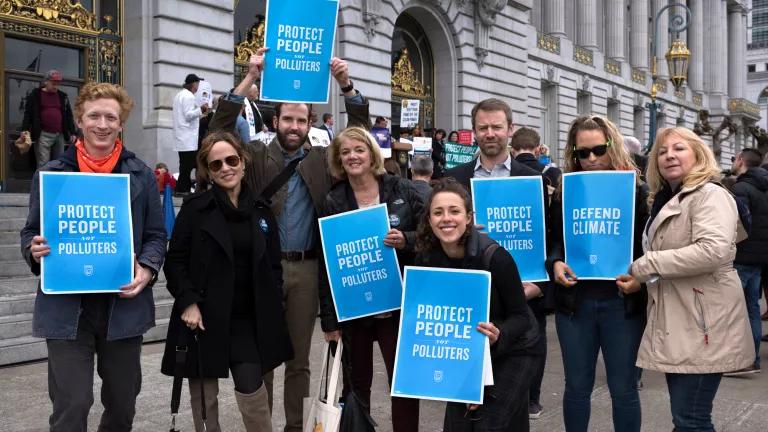California's publicly owned utilities have achieved tremendous energy efficiency successes over the past five years, working aggressively to lower customer bills by over $1 billion, create jobs, help the state meet its carbon pollution limit – and set an impressive example for public power nationwide.
Publicly owned utilities are governed by City Councils or Boards (rather than being regulated by Public Utility Commissions like the investor owned utilities) and are critical players in helping California achieve its economic and environmental goals. The state’s 40 publicly owned utilities, which include the Los Angeles Department of Water and Power and the Sacramento Municipal Utility District, provide about a quarter of the state’s electricity (as much as the entire state of Colorado consumes each year) and serve over 3 million households and businesses. Similarly, publicly owned utilities and cooperatives nationwide provide about one-quarter of the America’s power.
Today, NRDC and the Northern California Power Agency co-authored an article published in ElectricityPolicy.com highlighting California public power’s impressive achievement. The California utilities’ experience of ramping up efficiency programs and providing a billion dollars of bill savings to customers (and counting) can offer valuable examples for other states and publicly owned utilities looking to lower utility bills, spur economic growth, and cut pollution.
Dramatic Progress Over Five Years
California put into place a host of policies that set the stage for the publicly owned utilities to successfully capture energy savings. By making efficiency a top priority, setting aggressive targets, and ensuring utilities have funding to invest in efficiency programs and independently verify their savings, California public utilities have dramatically increased their energy savings.
Over the last five years, the utilities’ programs have:
- Saved customers more than $1 billion;
- Cut demand by about 400 megawatts, avoiding the need for a medium-sized power plant;
- Cut annual pollution equivalent to the emissions from more than 200,000 cars;
- Increased investments in energy efficiency programs -- such as helping customers improve their building weatherization and upgrade appliances -- to $125 million in 2010 (more than all utilities in the entire state of Texas invested in efficiency that year); and
- Increased reported annual energy savings due to energy efficiency programs more than three-fold (see the chart below).

More Savings to Come
Even with the state’s enormous progress, significant opportunities to save energy more cheaply than it can be produced remain untapped (meaning the publicly owned utilities can still capture more energy savings and save customers money). Over the next 10 years, the publicly owned utilities’ energy-saving goals aim to:
- Cut customers’ utility bills by more than an estimated $2 billion;
- Avoid the need to build two large power plants; and
- Reduce pollution equivalent to the emissions from about 570,000 cars.
Opportunities to Scale-Up Efficiency
California’s public utilities can expand their efficiency achievements even faster than noted above by adopting additional policies and programs. In our article, we offer the following recommendations for the publicly owned utilities:
- Continue to expand the range of cost-effective energy efficiency programs by reaching all sectors of the economy (e.g., manufacturers, retailers, contractors, and customers) and end-uses (e.g., appliances, plug loads, building shell, etc.);
- Fully integrate energy efficiency into resource planning to ensure that energy savings are directly displacing conventional sources of energy;
- Conduct comprehensive independent evaluation, measurement, and verification of efficiency programs to ensure that planners can rely on efficiency instead of dirty power and continue to improve such programs; and
- Continue to collaborate on program delivery to take advantage of commonalities and reduce costs.
In addition, the Los Angeles Department of Water and Power became the first publicly owned utility in the country to break the link between revenue and electricity sales, another model policy that could help public power accelerate efficiency efforts both state- and nation-wide. Traditionally, utilities earn more money the more energy they sell, creating a disincentive to invest in energy efficiency programs. Although publicly owned utilities do not have a profit motive like private utilities, they do have financial responsibilities including covering their fixed costs, paying bond holders, and often underwriting crucial city services; when retail electricity sales drop, these objectives are jeopardized. By adopting this policy, LADWP is more able to expand efforts that help customers save energy, through its own efficiency programs as well as by supporting strong state and federal standards, while maintaining its financial health.
Public power in California has made immense strides in energy efficiency and should continue to aggressively expand efficiency programs to lower customer bills, create new jobs, and help the state meet its clean energy targets. It has also shown great leadership on energy efficiency, resulting in enormous benefits. Hopefully these results will inspire public power around the country to take note and move quickly to increase their own energy efficiency programs to benefit their customers.




